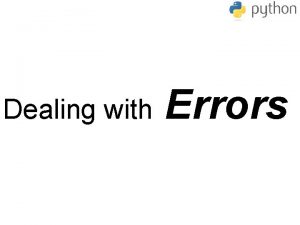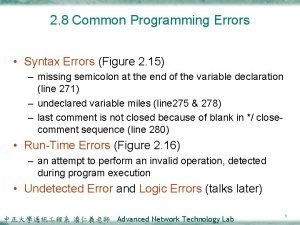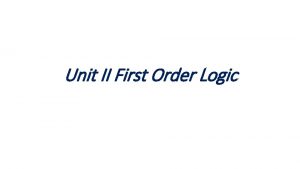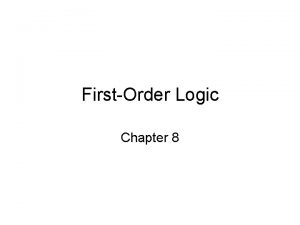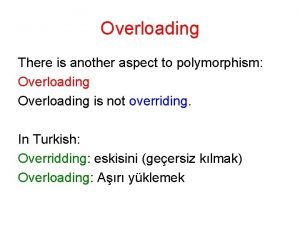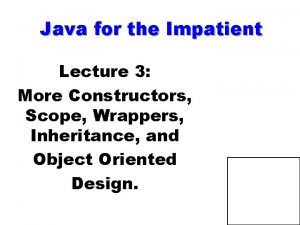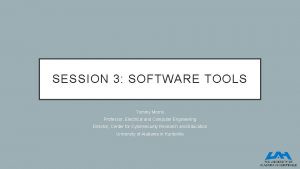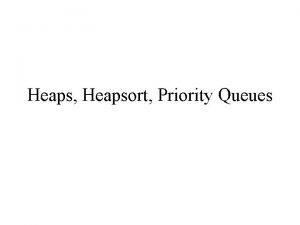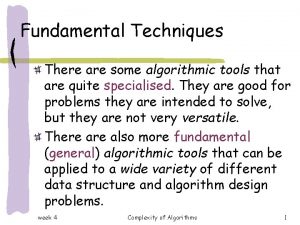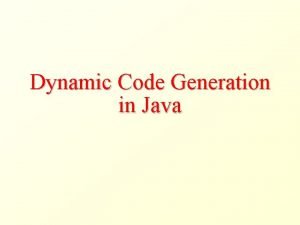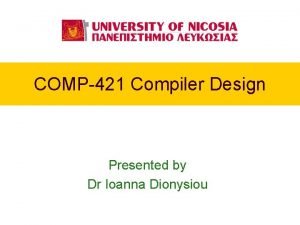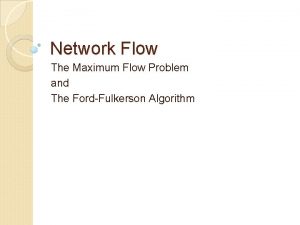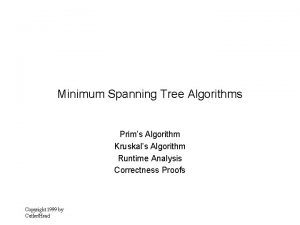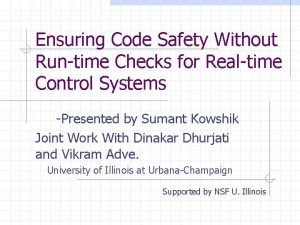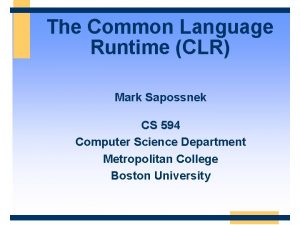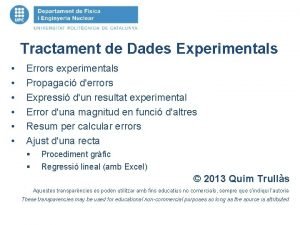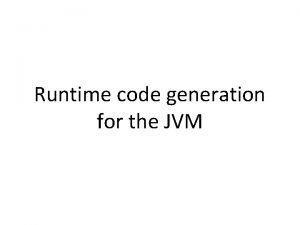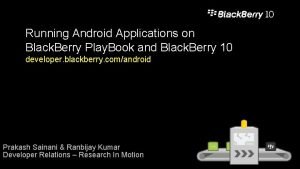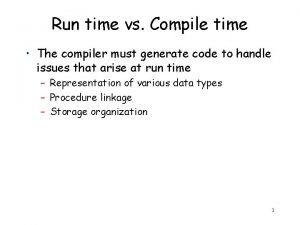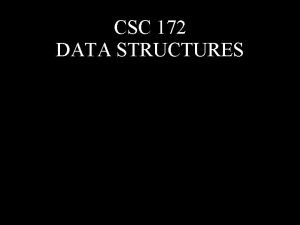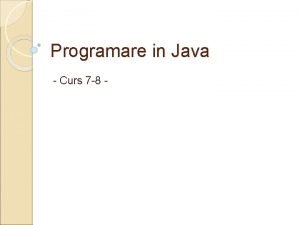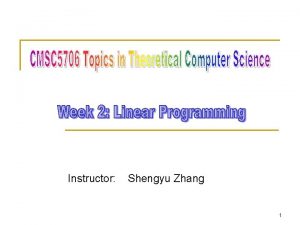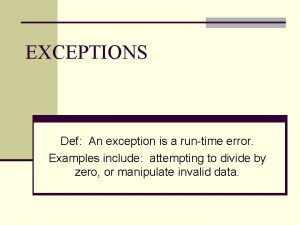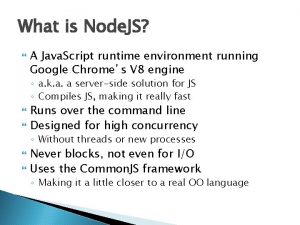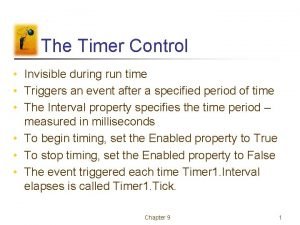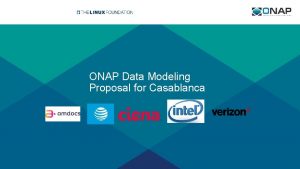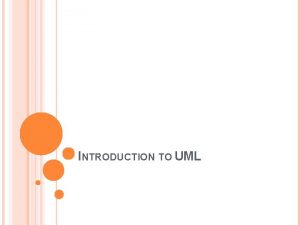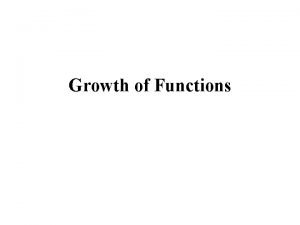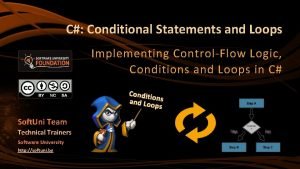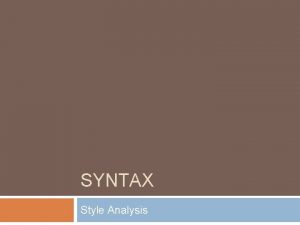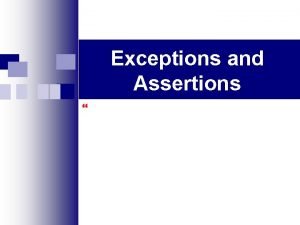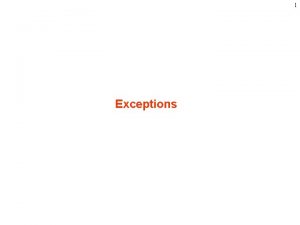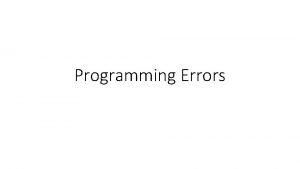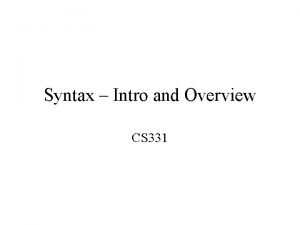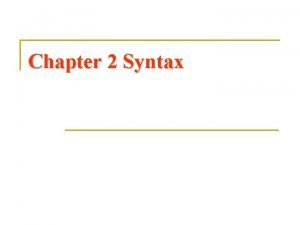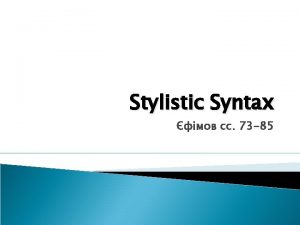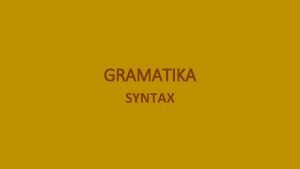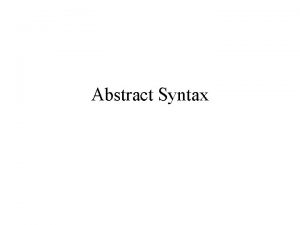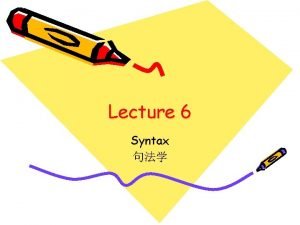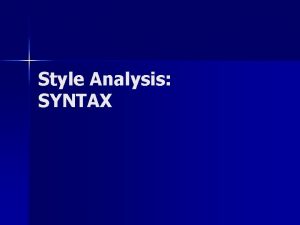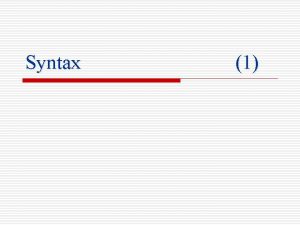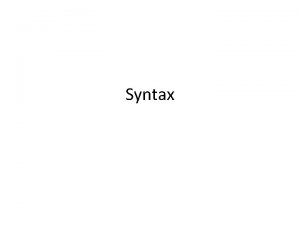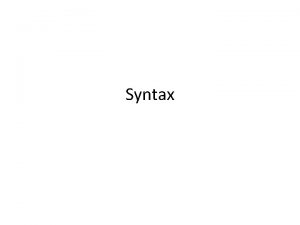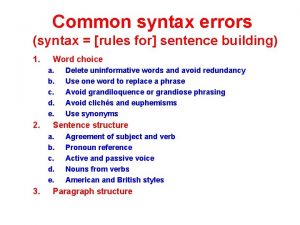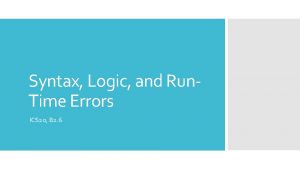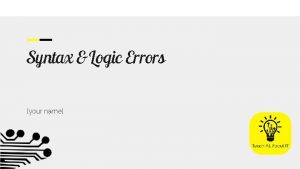Syntax Errors Runtime Errors and Logic Errors You










































![Executing Assertions Example public class Assertion. Demo { public static void main(String[] args) { Executing Assertions Example public class Assertion. Demo { public static void main(String[] args) {](https://slidetodoc.com/presentation_image_h2/9a19c5b824219ac420f4b6a179ac943c/image-43.jpg)






- Slides: 49

Syntax Errors, Runtime Errors, and Logic Errors You learned that there are three categories of errors: syntax errors, runtime errors, and logic errors. Syntax errors arise because the rules of the language have not been followed. They are detected by the compiler. Runtime errors occur while the program is running if the environment detects an operation that is impossible to carry out. Logic errors occur when a program doesn't perform the way it was intended to. Liang, Introduction to Java Programming, Sixth Edition, (c) 2007 Pearson Education, Inc. All rights reserved. 0 -13 -222158 -6 1

Runtime Errors Run Liang, Introduction to Java Programming, Sixth Edition, (c) 2007 Pearson Education, Inc. All rights reserved. 0 -13 -222158 -6 2

Catch Runtime Errors Run Liang, Introduction to Java Programming, Sixth Edition, (c) 2007 Pearson Education, Inc. All rights reserved. 0 -13 -222158 -6 3

Exception Classes Liang, Introduction to Java Programming, Sixth Edition, (c) 2007 Pearson Education, Inc. All rights reserved. 0 -13 -222158 -6 4

System Errors System errors are thrown by JVM and represented in the Error class. The Error class describes internal system errors. Such errors rarely occur. If one does, there is little you can do beyond notifying the user and trying to terminate the program gracefully. Liang, Introduction to Java Programming, Sixth Edition, (c) 2007 Pearson Education, Inc. All rights reserved. 0 -13 -222158 -6 5

Exceptions Exception describes errors caused by your program and external circumstances. These errors can be caught and handled by your program. Liang, Introduction to Java Programming, Sixth Edition, (c) 2007 Pearson Education, Inc. All rights reserved. 0 -13 -222158 -6 6

Runtime Exceptions Runtime. Exception is caused by programming errors, such as bad casting, accessing an out-of-bounds array, and numeric errors. Liang, Introduction to Java Programming, Sixth Edition, (c) 2007 Pearson Education, Inc. All rights reserved. 0 -13 -222158 -6 7

Checked Exceptions vs. Unchecked Exceptions Runtime. Exception, Error and their subclasses are known as unchecked exceptions. All other exceptions are known as checked exceptions, meaning that the compiler forces the programmer to check and deal with the exceptions. Liang, Introduction to Java Programming, Sixth Edition, (c) 2007 Pearson Education, Inc. All rights reserved. 0 -13 -222158 -6 8

Unchecked Exceptions In most cases, unchecked exceptions reflect programming logic errors that are not recoverable. For example, a Null. Pointer. Exception is thrown if you access an object through a reference variable before an object is assigned to it; an Index. Out. Of. Bounds. Exception is thrown if you access an element in an array outside the bounds of the array. These are the logic errors that should be corrected in the program. Unchecked exceptions can occur anywhere in the program. To avoid cumbersome overuse of try-catch blocks, Java does not mandate you to write code to catch unchecked exceptions. Liang, Introduction to Java Programming, Sixth Edition, (c) 2007 Pearson Education, Inc. All rights reserved. 0 -13 -222158 -6 9

Checked or Unchecked Exceptions Unchecked exception. Liang, Introduction to Java Programming, Sixth Edition, (c) 2007 Pearson Education, Inc. All rights reserved. 0 -13 -222158 -6 10

Declaring, Throwing, and Catching Exceptions Liang, Introduction to Java Programming, Sixth Edition, (c) 2007 Pearson Education, Inc. All rights reserved. 0 -13 -222158 -6 11

Declaring Exceptions Every method must state the types of checked exceptions it might throw. This is known as declaring exceptions. public void my. Method() throws IOException, Other. Exception Liang, Introduction to Java Programming, Sixth Edition, (c) 2007 Pearson Education, Inc. All rights reserved. 0 -13 -222158 -6 12

Throwing Exceptions When the program detects an error, the program can create an instance of an appropriate exception type and throw it. This is known as throwing an exception. Here is an example, throw new The. Exception(); The. Exception ex = new The. Exception(); throw ex; Liang, Introduction to Java Programming, Sixth Edition, (c) 2007 Pearson Education, Inc. All rights reserved. 0 -13 -222158 -6 13

Throwing Exceptions Example /** Set a new radius */ public void set. Radius(double new. Radius) throws Illegal. Argument. Exception { if (new. Radius >= 0) radius = new. Radius; else throw new Illegal. Argument. Exception( "Radius cannot be negative"); } Liang, Introduction to Java Programming, Sixth Edition, (c) 2007 Pearson Education, Inc. All rights reserved. 0 -13 -222158 -6 14

Catching Exceptions try { statements; // Statements that may throw exceptions } catch (Exception 1 ex. Var 1) { handler for exception 1; } catch (Exception 2 ex. Var 2) { handler for exception 2; }. . . catch (Exception. N ex. Var 3) { handler for exception. N; } Liang, Introduction to Java Programming, Sixth Edition, (c) 2007 Pearson Education, Inc. All rights reserved. 0 -13 -222158 -6 15

Catching Exceptions Liang, Introduction to Java Programming, Sixth Edition, (c) 2007 Pearson Education, Inc. All rights reserved. 0 -13 -222158 -6 16

Catch or Declare Checked Exceptions Java forces you to deal with checked exceptions. If a method declares a checked exception (i. e. , an exception other than Error or Runtime. Exception), you must invoke it in a try-catch block or declare to throw the exception in the calling method. For example, suppose that method p 1 invokes method p 2 and p 2 may throw a checked exception (e. g. , IOException), you have to write the code as shown in (a) or (b). Liang, Introduction to Java Programming, Sixth Edition, (c) 2007 Pearson Education, Inc. All rights reserved. 0 -13 -222158 -6 17

Example: Declaring, Throwing, and Catching Exceptions F Objective: This example demonstrates declaring, throwing, and catching exceptions by modifying the set. Radius method in the Circle class defined in Chapter 6. The new set. Radius method throws an exception if radius is negative. Test. Circle. With. Exception Run Liang, Introduction to Java Programming, Sixth Edition, (c) 2007 Pearson Education, Inc. All rights reserved. 0 -13 -222158 -6 18

Exceptions in GUI Applications The methods are executed on the threads. If an exception occurs on a thread, the thread is terminated if the exception is not handled. However, the other threads in the application are not affected. There are several threads running to support a GUI application. A thread is launched to execute an event handler (e. g. , the action. Performed method for the Action. Event). If an exception occurs during the execution of a GUI event handler, the thread is terminated if the exception is not handled. Interestingly, Java prints the error message on the console, but does not terminate the application. The program goes back to its user-interface-processing loop to run continuously. Liang, Introduction to Java Programming, Sixth Edition, (c) 2007 Pearson Education, Inc. All rights reserved. 0 -13 -222158 -6 19

Example: Exceptions in GUI Applications F An error message appears on the console, but the GUI application continues running. F Write a program that creates a user interface to perform integer divisions. The user enters two numbers in the text fields Number 1 and Number 2. The division of Number 1 and Number 2 is displayed in the Result field when the Divide button is clicked. Integer. Division Run Liang, Introduction to Java Programming, Sixth Edition, (c) 2007 Pearson Education, Inc. All rights reserved. 0 -13 -222158 -6 20

Rethrowing Exceptions try { statements; } catch(The. Exception ex) { perform operations before exits; throw ex; } Liang, Introduction to Java Programming, Sixth Edition, (c) 2007 Pearson Education, Inc. All rights reserved. 0 -13 -222158 -6 21

The finally Clause try { statements; } catch(The. Exception ex) { handling ex; } finally { final. Statements; } Liang, Introduction to Java Programming, Sixth Edition, (c) 2007 Pearson Education, Inc. All rights reserved. 0 -13 -222158 -6 22

animation Trace a Program Execution Suppose no exceptions in the statements try { statements; } catch(The. Exception ex) { handling ex; } finally { final. Statements; } Next statement; Liang, Introduction to Java Programming, Sixth Edition, (c) 2007 Pearson Education, Inc. All rights reserved. 0 -13 -222158 -6 23

animation Trace a Program Execution try { statements; } catch(The. Exception ex) { handling ex; } finally { final. Statements; } The final block is always executed Next statement; Liang, Introduction to Java Programming, Sixth Edition, (c) 2007 Pearson Education, Inc. All rights reserved. 0 -13 -222158 -6 24

animation Trace a Program Execution try { statements; } catch(The. Exception ex) { handling ex; } finally { final. Statements; } Next statement in the method is executed Next statement; Liang, Introduction to Java Programming, Sixth Edition, (c) 2007 Pearson Education, Inc. All rights reserved. 0 -13 -222158 -6 25

animation Trace a Program Execution try { statement 1; statement 2; statement 3; } catch(Exception 1 ex) { handling ex; } finally { final. Statements; } Suppose an exception of type Exception 1 is thrown in statement 2 Next statement; Liang, Introduction to Java Programming, Sixth Edition, (c) 2007 Pearson Education, Inc. All rights reserved. 0 -13 -222158 -6 26

animation Trace a Program Execution try { statement 1; statement 2; statement 3; } catch(Exception 1 ex) { handling ex; } finally { final. Statements; } The exception is handled. Next statement; Liang, Introduction to Java Programming, Sixth Edition, (c) 2007 Pearson Education, Inc. All rights reserved. 0 -13 -222158 -6 27

animation Trace a Program Execution try { statement 1; statement 2; statement 3; } catch(Exception 1 ex) { handling ex; } finally { final. Statements; } The final block is always executed. Next statement; Liang, Introduction to Java Programming, Sixth Edition, (c) 2007 Pearson Education, Inc. All rights reserved. 0 -13 -222158 -6 28

animation Trace a Program Execution try { statement 1; statement 2; statement 3; } catch(Exception 1 ex) { handling ex; } finally { final. Statements; } The next statement in the method is now executed. Next statement; Liang, Introduction to Java Programming, Sixth Edition, (c) 2007 Pearson Education, Inc. All rights reserved. 0 -13 -222158 -6 29

animation Trace a Program Execution try { statement 1; statement 2; statement 3; } catch(Exception 1 ex) { handling ex; } catch(Exception 2 ex) { handling ex; throw ex; } finally { final. Statements; } statement 2 throws an exception of type Exception 2. Next statement; Liang, Introduction to Java Programming, Sixth Edition, (c) 2007 Pearson Education, Inc. All rights reserved. 0 -13 -222158 -6 30

animation Trace a Program Execution try { statement 1; statement 2; statement 3; } catch(Exception 1 ex) { handling ex; } catch(Exception 2 ex) { handling ex; throw ex; } finally { final. Statements; } Handling exception Next statement; Liang, Introduction to Java Programming, Sixth Edition, (c) 2007 Pearson Education, Inc. All rights reserved. 0 -13 -222158 -6 31

animation Trace a Program Execution try { statement 1; statement 2; statement 3; } catch(Exception 1 ex) { handling ex; } catch(Exception 2 ex) { handling ex; throw ex; } finally { final. Statements; } Execute the final block Next statement; Liang, Introduction to Java Programming, Sixth Edition, (c) 2007 Pearson Education, Inc. All rights reserved. 0 -13 -222158 -6 32

animation Trace a Program Execution try { statement 1; statement 2; statement 3; } catch(Exception 1 ex) { handling ex; } catch(Exception 2 ex) { handling ex; throw ex; } finally { final. Statements; } Rethrow the exception and control is transferred to the caller Next statement; Liang, Introduction to Java Programming, Sixth Edition, (c) 2007 Pearson Education, Inc. All rights reserved. 0 -13 -222158 -6 33

Cautions When Using Exceptions F Exception handling separates error-handling code from normal programming tasks, thus making programs easier to read and to modify. Be aware, however, that exception handling usually requires more time and resources because it requires instantiating a new exception object, rolling back the call stack, and propagating the errors to the calling methods. Liang, Introduction to Java Programming, Sixth Edition, (c) 2007 Pearson Education, Inc. All rights reserved. 0 -13 -222158 -6 34

When to Throw Exceptions F An exception occurs in a method. If you want the exception to be processed by its caller, you should create an exception object and throw it. If you can handle the exception in the method where it occurs, there is no need to throw it. Liang, Introduction to Java Programming, Sixth Edition, (c) 2007 Pearson Education, Inc. All rights reserved. 0 -13 -222158 -6 35

When to Use Exceptions When should you use the try-catch block in the code? You should use it to deal with unexpected error conditions. Do not use it to deal with simple, expected situations. For example, the following code try { System. out. println(ref. Var. to. String()); } catch (Null. Pointer. Exception ex) { System. out. println("ref. Var is null"); } Liang, Introduction to Java Programming, Sixth Edition, (c) 2007 Pearson Education, Inc. All rights reserved. 0 -13 -222158 -6 36

When to Use Exceptions is better to be replaced by if (ref. Var != null) System. out. println(ref. Var. to. String()); else System. out. println("ref. Var is null"); Liang, Introduction to Java Programming, Sixth Edition, (c) 2007 Pearson Education, Inc. All rights reserved. 0 -13 -222158 -6 37

Creating Custom Exception Classes F Use the exception classes in the API whenever possible. F Create custom exception classes if the predefined classes are not sufficient. F Declare custom exception classes by extending Exception or a subclass of Exception. Liang, Introduction to Java Programming, Sixth Edition, (c) 2007 Pearson Education, Inc. All rights reserved. 0 -13 -222158 -6 38

Custom Exception Class Example In Listing 17. 1, the set. Radius method throws an exception if the radius is negative. Suppose you wish to pass the radius to the handler, you have to create a custom exception class. Invalid. Radius. Exception Circle. With. Radius. Exception Test. Circle. With. Radius. Exception Run Liang, Introduction to Java Programming, Sixth Edition, (c) 2007 Pearson Education, Inc. All rights reserved. 0 -13 -222158 -6 39

Assertions An assertion is a Java statement that enables you to assert an assumption about your program. An assertion contains a Boolean expression that should be true during program execution. Assertions can be used to assure program correctness and avoid logic errors. Liang, Introduction to Java Programming, Sixth Edition, (c) 2007 Pearson Education, Inc. All rights reserved. 0 -13 -222158 -6 40

Declaring Assertions An assertion is declared using the new Java keyword assert in JDK 1. 4 as follows: assertion; or assertion : detail. Message; where assertion is a Boolean expression and detail. Message is a primitive-type or an Object value. Liang, Introduction to Java Programming, Sixth Edition, (c) 2007 Pearson Education, Inc. All rights reserved. 0 -13 -222158 -6 41

Executing Assertions When an assertion statement is executed, Java evaluates the assertion. If it is false, an Assertion. Error will be thrown. The Assertion. Error class has a no-arg constructor and seven overloaded single-argument constructors of type int, long, float, double, boolean, char, and Object. For the first assert statement with no detail message, the no-arg constructor of Assertion. Error is used. For the second assert statement with a detail message, an appropriate Assertion. Error constructor is used to match the data type of the message. Since Assertion. Error is a subclass of Error, when an assertion becomes false, the program displays a message on the console and exits. Liang, Introduction to Java Programming, Sixth Edition, (c) 2007 Pearson Education, Inc. All rights reserved. 0 -13 -222158 -6 42
![Executing Assertions Example public class Assertion Demo public static void mainString args Executing Assertions Example public class Assertion. Demo { public static void main(String[] args) {](https://slidetodoc.com/presentation_image_h2/9a19c5b824219ac420f4b6a179ac943c/image-43.jpg)
Executing Assertions Example public class Assertion. Demo { public static void main(String[] args) { int i; int sum = 0; for (i = 0; i < 10; i++) { sum += i; } assert i == 10; assert sum > 10 && sum < 5 * 10 : "sum is " + sum; } } Liang, Introduction to Java Programming, Sixth Edition, (c) 2007 Pearson Education, Inc. All rights reserved. 0 -13 -222158 -6 43

Compiling Programs with Assertions Since assert is a new Java keyword introduced in JDK 1. 4, you have to compile the program using a JDK 1. 4 compiler. Furthermore, you need to include the switch –source 1. 4 in the compiler command as follows: javac –source 1. 4 Assertion. Demo. java NOTE: If you use JDK 1. 5, there is no need to use the –source 1. 4 option in the command. Liang, Introduction to Java Programming, Sixth Edition, (c) 2007 Pearson Education, Inc. All rights reserved. 0 -13 -222158 -6 44

Running Programs with Assertions By default, the assertions are disabled at runtime. To enable it, use the switch –enableassertions, or –ea for short, as follows: java –ea Assertion. Demo Assertions can be selectively enabled or disabled at class level or package level. The disable switch is – disableassertions or –da for short. For example, the following command enables assertions in package 1 and disables assertions in class Class 1. java –ea: package 1 –da: Class 1 Assertion. Demo Liang, Introduction to Java Programming, Sixth Edition, (c) 2007 Pearson Education, Inc. All rights reserved. 0 -13 -222158 -6 45

Using Exception Handling or Assertions Assertion should not be used to replace exception handling. Exception handling deals with unusual circumstances during program execution. Assertions are to assure the correctness of the program. Exception handling addresses robustness and assertion addresses correctness. Like exception handling, assertions are not used for normal tests, but for internal consistency and validity checks. Assertions are checked at runtime and can be turned on or off at startup time. Liang, Introduction to Java Programming, Sixth Edition, (c) 2007 Pearson Education, Inc. All rights reserved. 0 -13 -222158 -6 46

Using Exception Handling or Assertions, cont. Do not use assertions for argument checking in public methods. Valid arguments that may be passed to a public method are considered to be part of the method’s contract. The contract must always be obeyed whether assertions are enabled or disabled. For example, the following code should be rewritten using exception handling as shown in Lines 28 -35 in Circle. java in Listing 17. 1. public void set. Radius(double new. Radius) { assert new. Radius >= 0; radius = new. Radius; } Liang, Introduction to Java Programming, Sixth Edition, (c) 2007 Pearson Education, Inc. All rights reserved. 0 -13 -222158 -6 47

Using Exception Handling or Assertions, cont. Use assertions to reaffirm assumptions. This gives you more confidence to assure correctness of the program. A common use of assertions is to replace assumptions with assertions in the code. Liang, Introduction to Java Programming, Sixth Edition, (c) 2007 Pearson Education, Inc. All rights reserved. 0 -13 -222158 -6 48

Using Exception Handling or Assertions, cont. Another good use of assertions is place assertions in a switch statement without a default case. For example, switch (month) { case 1: . . . ; break; case 2: . . . ; break; . . . case 12: . . . ; break; default: assert false : "Invalid month: " + month } Liang, Introduction to Java Programming, Sixth Edition, (c) 2007 Pearson Education, Inc. All rights reserved. 0 -13 -222158 -6 49
 Runtime errors examples
Runtime errors examples Syntax directed definition
Syntax directed definition Common programming errors
Common programming errors First order logic syntax
First order logic syntax Syntax of first order logic
Syntax of first order logic First order logic vs propositional logic
First order logic vs propositional logic First order logic vs propositional logic
First order logic vs propositional logic Third order logic
Third order logic Concurrent vs sequential
Concurrent vs sequential Tw
Tw 캠블리 단점
캠블리 단점 Majority circuit
Majority circuit Combinational logic sequential logic 차이
Combinational logic sequential logic 차이 Logic chapter three
Logic chapter three Difference between compile time and runtime
Difference between compile time and runtime Constructors
Constructors Subdivision of runtime memory in compiler design
Subdivision of runtime memory in compiler design System programming definition
System programming definition Openplc runtime
Openplc runtime Kinect for windows speech recognition language pack
Kinect for windows speech recognition language pack Heapify runtime
Heapify runtime Matrix multiplication runtime
Matrix multiplication runtime Runtime error index out of bounds
Runtime error index out of bounds Java dynamic code generation
Java dynamic code generation Activation tree in compiler design
Activation tree in compiler design Ford fulkerson runtime
Ford fulkerson runtime Prims algorithm runtime
Prims algorithm runtime Basic runtime checks
Basic runtime checks Clr c#
Clr c# Heapify runtime
Heapify runtime Control hijacking
Control hijacking Kernel mode driver framework runtime
Kernel mode driver framework runtime Runtime error 9
Runtime error 9 Java runtime code generation
Java runtime code generation Blackberry runtime for android applications
Blackberry runtime for android applications Compile time vs run time
Compile time vs run time In futuregrid runtime adaptable insertion service used for
In futuregrid runtime adaptable insertion service used for In futuregrid runtime adaptable insertion service
In futuregrid runtime adaptable insertion service In futuregrid runtime adaptable
In futuregrid runtime adaptable Dfs runtime
Dfs runtime Tema java
Tema java Simplex algorithm runtime
Simplex algorithm runtime An exception is a runtime error
An exception is a runtime error Javascript runtime environment
Javascript runtime environment The control which is invisible at runtime
The control which is invisible at runtime Casablanca runtime
Casablanca runtime Structural view in uml
Structural view in uml Growth of functions
Growth of functions Softuni judge runtime error
Softuni judge runtime error Windows runtime component
Windows runtime component
